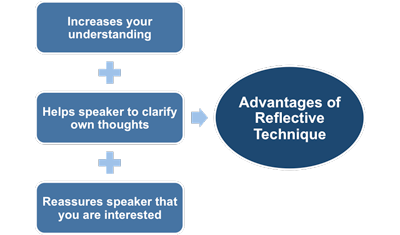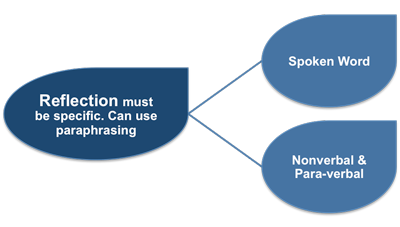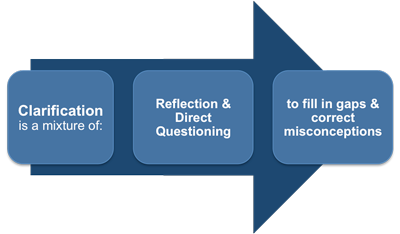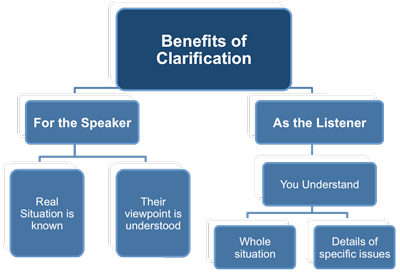Active Listening Skills - Reflective Technique
The second component of active listening is the reflective technique, which involves reflecting back to the speaker what it is you believe they mean. However, it also has a second major element, which is the clarification of the meaning of what has been heard.
In practice, reflection and clarification are intertwined, in that reflection often leads to some degree of clarification, and attempts at clarification often require some degree of reflection.
 |
The advantages of this technique are threefold:
• It increases your own understanding
• It helps the speaker to clarify his or her own thoughts
• It can reassure them that you are interested in their point of view.
Reflection
The term 'restatement' is often applied to this part of the technique because it involves paraphrasing the speaker's words back to them as a question. For example:
Speaker: 'I don't think that's possible.'
Listener: 'Are you saying that it's not possible to fulfill the order by Friday with the staff we have available?'
The most important part of this approach is that it must take account of the speaker's nonverbal signs as well as the actual words they use.
When employing verbal reflection, shorter interjections have the advantage that they interrupt the flow of the narrative less. Keeping your questions brief also forces you to stick to the main points, but it is not always possible because you do need to be specific rather than general.
 |
By using reflection, the speaker can see that you are paying attention to them and making a conscious effort to understand what they mean. If you want to do this verbally you can use phrases or supportive sounds such as 'Yes,' 'Go on,' 'Ah ha,' 'OK,' or 'Mm.' Altering your posture slightly (for example, moving forward) or nodding your head shows you are taking on board what they are saying. You can also use the appropriate facial expression or make eye contact to signal to the speaker you are listening to them.
This tends to encourage people to open up and make their case in an honest and heartfelt way. If you feel there is more to explore you can use paraphrasing of the last few words spoken or an open question to keep the conversation alive. In some instances you may just want to remain quiet in order to give the speaker time to gather their thoughts again. These simple techniques can help bring to light issues that you were previously unaware of.
Clarification
A mixture of reflection and direct questioning can get to the bottom of what people mean. These approaches enable you to correct misunderstandings and fill gaps in the narrative, thus gaining a better understanding of the overall situation.
 |
The process of reflection provides an opportunity for the speaker to point out inaccuracies in your understanding. However, you need to be aware that they may not take the initiative to do so. Consequently, you should pay close attention to their body language and be on the look out for nonverbal signs that might indicate that you have misinterpreted their meaning.
Another thing to be aware of is that you can only clarify information that the speaker has articulated. If you suspect that significant information is being withheld, you cannot reflect it in the usual way, because you don't know what it is. Instead, you have to somehow reflect its absence by asking questions that lead the speaker to bring it into the open.
 |
From your perspective, the end result of clarification is a fuller and more accurate understanding of the overall situation and a detailed understanding of specific issues. From the speaker's perspective, the end result should be a feeling that their circumstances and point of view have been understood.
Central to this process is the fact that you need to overcome any natural tendency that you may have to rush in with suggestions or solutions. If you do not, you will be unable to avoid acknowledging your own emotions during the communication. You need to allow the speaker to present the whole picture so that they expose the level of their knowledge and the extent of their ideas on how to address the issue in hand.
Some simple techniques you can use to ensure that you ask for clarification rather than offer your own opinion are as follows:
• State what you think the speaker has said, as you understand it
• Check whether this is what they really meant
• Use open, non-directive questions - if appropriate
• Ask if you have got it right and be prepared to be corrected
• Admit if you are unsure about what the speaker means
• Ask for specific examples where necessary or if helpful for understanding.
By allowing several seconds of silence before you ask a question or give feedback you will ensure that the speaker has said all they want to. You can also indicate your attentiveness by accurately paraphrasing the speaker's words into a statement that communicates your impartiality and comprehension. It also allows you to clarify that you have understood their explanation of the issue.
When using clarification, a significant part of the technique is your ability to summarize the whole communication exchange, thereby illustrating your understanding of what has been said. In your summary be concise, objective, and non-judgmental, using the speaker's frame of reference to describe the essential elements of your conversation.
Where this conversation is part of several discussions you will often use your previous summary at the beginning of your next conversation to refresh and restate your current understanding. Active Listening Tips - Good listeners' detach themselves from their own concerns, attitudes, and ideas whilst they are listening. You achieve this by removing such distractions allowing you to observe both the conscious and unconscious signs of the speaker. You are then able to identify any discrepancies between these two signs and discern the true meaning of what has been said.
You may also be interested in:
Active Listening Skills for Managers | Definition of Active Listening | Questioning Skills | Barriers to Active Listening | Advantages of Active Listening.



